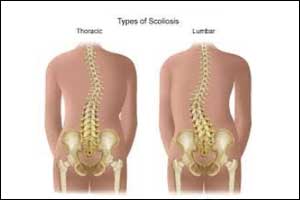- Home
- Editorial
- News
- Practice Guidelines
- Anesthesiology Guidelines
- Cancer Guidelines
- Cardiac Sciences Guidelines
- Critical Care Guidelines
- Dentistry Guidelines
- Dermatology Guidelines
- Diabetes and Endo Guidelines
- Diagnostics Guidelines
- ENT Guidelines
- Featured Practice Guidelines
- Gastroenterology Guidelines
- Geriatrics Guidelines
- Medicine Guidelines
- Nephrology Guidelines
- Neurosciences Guidelines
- Obs and Gynae Guidelines
- Ophthalmology Guidelines
- Orthopaedics Guidelines
- Paediatrics Guidelines
- Psychiatry Guidelines
- Pulmonology Guidelines
- Radiology Guidelines
- Surgery Guidelines
- Urology Guidelines
Should all children be routinely screened for Scoliosis?

It’s unclear if all children and teens can benefit from routine screening for scoliosis, according to a new statement from a panel of U.S. medical experts.
Even though wearing a back brace may stop scoliosis from getting worse, it’s not clear whether this treatment has long-term benefits for youngsters without obvious symptoms who are identified with scoliosis through routine screening, said Dr. Alex Kemper, a member of the U.S. Preventive Services Task Force (USPSTF), a government-backed independent panel of physicians and health specialists.
There isn’t enough evidence yet to say whether treating scoliosis because of an abnormal screen leads to improvements in health that last into adulthood, Kemper, a researcher at Nationwide Children’s Hospital in Columbus, Ohio, said by email.
The USPSTF statement doesn’t apply to youth who have visible curvature in their spine or other, more subtle hallmarks of scoliosis such as slight misalignments around the shoulders, hips or rib cage.
When the Task Force last weighed in on this issue in 2004, the expert panel recommended against routine scoliosis screening out of concern that patients might be harmed by unnecessary treatment.
In particular, one experiment with 242 young scoliosis patients found wearing a back brace at least 18 hours a day is more effective than observation for preventing curvatures from worsening.
This study helped sway other medical societies, including the American Academy of Pediatrics, to formally recommend routine screening in 2015, said Dr. Timothy Hresko, author of an editorial in JAMA Pediatrics accompanying the new USPSTF statement.
“With the value of bracing now confirmed, the results of this study emphasized the need for early detection of scoliosis so that brace treatment can be offered to patients,” said Hresko, an orthopedic surgery researcher at Harvard Medical School and Boston Children’s Hospital.
Access to quality screening remains a concern, however, Hresko said by email.
Screening is usually done by looking for curves along the spine as well as asymmetry around the back, shoulders and hips. Patients who appear to have scoliosis with screening may have the diagnosis confirmed with x-rays or magnetic resonance imaging.
Even though there aren’t any obvious harms or side effects from the screening itself, children might suffer psychological distress if they are inaccurately told they have scoliosis based on screening, and they might also suffer needless testing and treatment, the Task Force notes.
Long-term studies also haven’t proven how much routine screening can help reduce the number of adults with scoliosis who suffer from breathing problems, back pain, disability or reduced quality of life, the Task Force points out.
Parents should still see a doctor if they’re concerned that their child might have scoliosis, said Dr. John Francis Sarwark, author of an accompanying editorial in JAMA and a researcher at the Northwestern University Feinberg School of Medicine and the Ann & Robert H. Lurie Children’s Hospital of Chicago.
“Keep in mind that most children do not require treatment for normal findings, minor findings or mild scoliosis,” Sarwark advised.
For more details click on the link: http://jamanetwork.com/journals/jama/fullarticle/10.1001/jama.2017.19342

Disclaimer: This site is primarily intended for healthcare professionals. Any content/information on this website does not replace the advice of medical and/or health professionals and should not be construed as medical/diagnostic advice/endorsement or prescription. Use of this site is subject to our terms of use, privacy policy, advertisement policy. © 2020 Minerva Medical Treatment Pvt Ltd